The Foundation
I want to create a foundation in my home in the Marais to house my collections of fashion history, art and design in addition to my own archives. Azzedine Alaïa
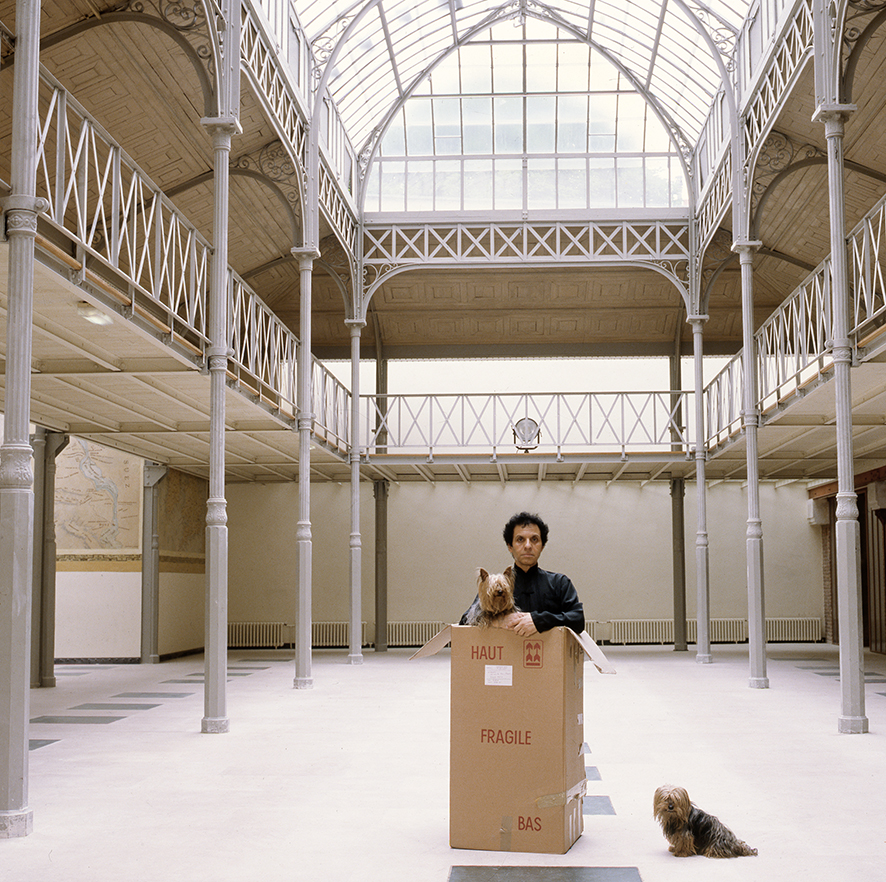
Azzedine Alaïa ph. Snowdon / Trunk Archive
Azzedine Alaïa lived a life filled with fashion, art, design, architecture, music and theatre. For over fifty years, he had been an avid collector in all creative and cultural disciplines.
In 2007, with the painter Christoph Von Weyhe and his close friend of forty years, the publisher and gallerist Carla Sozzani he set about to preserve his own work and his large holdings by founding the Association Azzedine Alaïa, to later become the Fondation Azzedine Alaïa.
The Foundation bears a logo created by Julian Schnabel. The Foundation is located in Paris at 18, rue de la Verrerie where Azzedine Alaïa lived and worked. The Foundation is housed in a group of buildings set around an interior courtyard, landscaped with plants. At the end of the courtyard, the large exhibition gallery with a glass and ironwork roof, and on the first floor, a second exhibition gallery. There is also a bookshop dedicated to fashion, art, design, and literature, and a café in memory of Monsieur Alaïa’s famous hospitality.
As of the 28th of February 2020, the Fondation Azzedine Alaia has by decree of the “Ministère de l’Intérieur” (French Ministry of Interior) been recognized as an establishment of public utility. As was the wish of Azzedine Alaïa before his passing, the missions of the Foundation are to preserve and showcase the work of Azzedine Alaïa, and the many works from the disciplines of art, fashion and design that he collected over the course of his lifetime, to organize exhibitions and to support cultural and educational activities.
In collaboration with diverse cultural institutions, the Azzedine Alaïa Foundation has undertake the patronage of the Association’s diverse cultural program, enabling it to continue its activities of public utility and to provide to the projects that it holds dear the same support as over the last thirteen years.
The Azzedine Alaïa Foundation exhibits the work of Azzedine Alaïa and the works of art from his personal collection.
The mission of the Foundation are:
- to protect, to conserve and to showcase the work of Azzedine Alaïa, and the many works from the disciplines of art, fashion and design that he collected over the course of his lifetime.
- to organize exhibitions and to publish quality books and works of reference.
- to support cultural and educational activities.
The Foundation also fulfills an educational mandate via collaborations with fashion schools and institutions, the Foundation host conferences and research programs on the Alaïa collection, rich in over 35,000 pieces.
The Foundation also award bursaries to promising visionaries in fashion.
BOARD OF trustees & officers

Azzedine Alaïa in his dining room ph. Suzanne Rault Balet/Getty Images/Sygma
FOUNDERS
THE GOVERNANCE
The Board of Directors is made up of personalities who have worked alongside Azzedine Alaïa and internationally renowned institutions that play a leading role in the world of arts and culture.
The meetings of the Board of Directors are held the former dining room of Azzedine Alaïa. This superb room surmounted by a small glass roof, with a floor in frosted glass and at the center a large table with crystal legs, is decorated with two illuminated side tables in glass and steel designed by Marius Sabino in the 1930’s. Chairs by Jean Prouvé complement the ensemble; all these pieces of furniture already decorated the dining room of Alaïa’s previous headquarters at 17 rue du Parc Royal.
It is in this room, located between his studio and his apartment, that Azzedine Alaïa would host intimate dinner parties in the 1990’s, before installing a large kitchen dining room on the ground floor in 2002. From that date onwards, he would use this room solely to store the pieces of his collections and works of art that were dearest to him.
OFFICERS
PRESIDENT
Carla Sozzani
COUNCILLOR
TREASURER
DIRECTOR
BOARD OF TRUSTEES
COLLEGE OF FOUNDERS
Carla Sozzani
Ugo Supino
COLLEGE OF QUALIFIED PERSONALITIES
Fabrice Hergott
COLLEGE OF INSTITUTIONAL PARTNERS
Musée des Arts Décoratifs, Lionel Sauvage
The Metropolitan Museum of Art, Andrew Bolton
COLLEGE OF FRIENDS OF AZZEDINE ALAÏA
COLLEGE OF PATRONS
Partner patron, Richemont International SA, Anne Dellière
Partner patron, Fondation Cartier pour l’Art Contemporain, Chris Dercon
Active patron, Kris Ruhs
GOVERNMENT COMMISSIONER
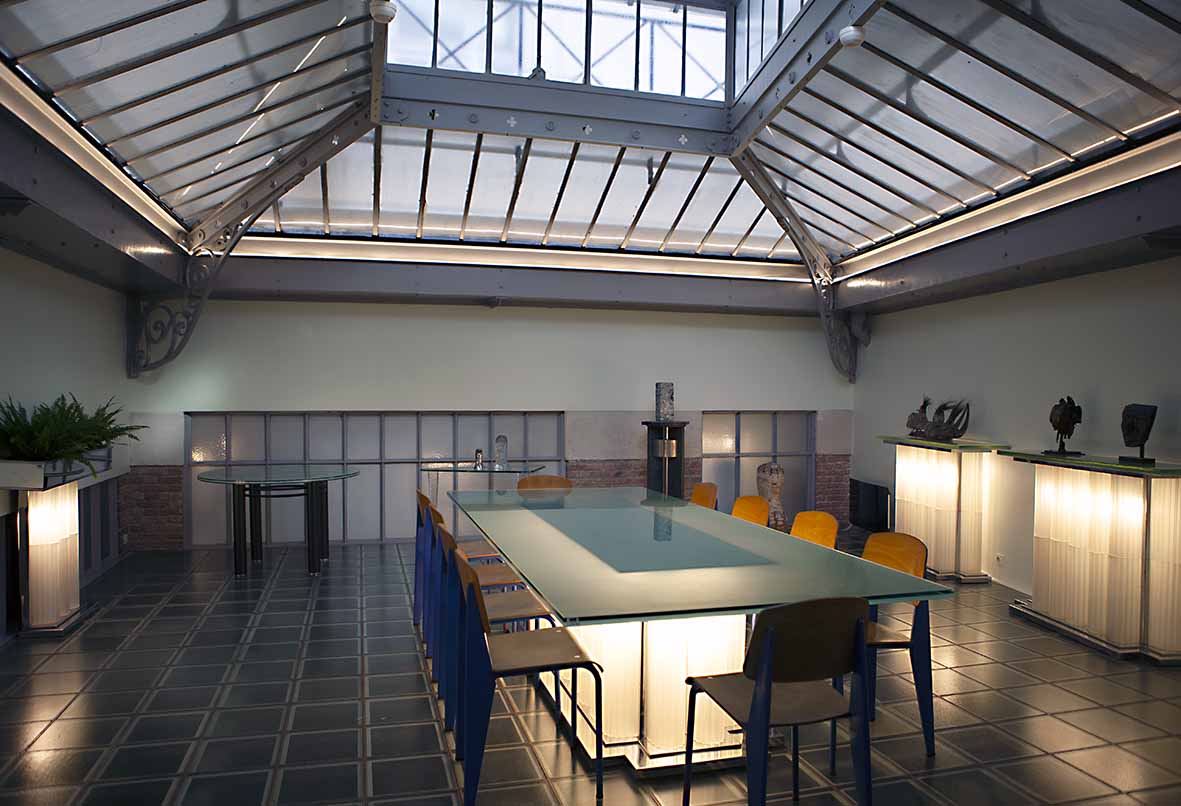
the conference room, once the azzedine alaïa’s dining room ph. Sylvie delpech
activity reports
Find here the different activity reports of the Azzedine Alaïa Foundation.
Annual activity report - 2023
Annual activity report - 2022
Annual activity report - 2021
Annual activity report - 2018/2019/2020
The Friends of Azzedine Alaïa
All of my friends help me to stay in tune with the times. Azzedine Alaïa
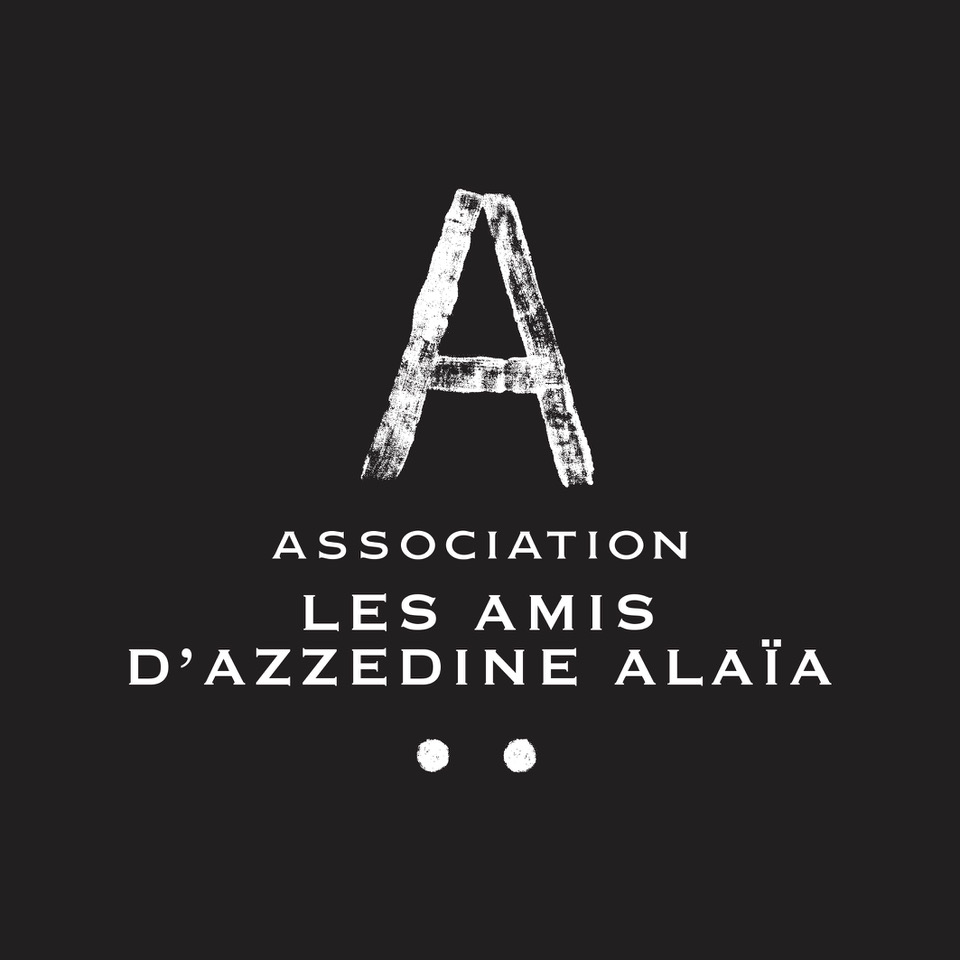
logo association of friends of azzedine alaïa
I'm happier about my friends than I am about my work. I still have a long way to go with work. My friends, that's the one thing I'm sure about. Azzedine Alaïa
The association "THE FRIENDS OF AZZEDINE ALAÏA" means topass on to future generations the philosophy of Azzedine Alaïa, his vision of the world, his values, his work ethic, his humanity.
The Association "THE FRIENDS OF AZZEDINE ALAÏA" contributes to the objective of the Foundation, to promote the work and philosophy of the couturier, and its purpose is to, both in France and abroad:
Support the Foundation, accompanying the Foundation in the implementation of its’ general approach and assisting in the pursuit of its’ activities, in particular upholding and facilitating the transmission of the values and savoir-faire of Azzedine Alaïa to talented young people in the domains of fashion, couture, and the major and minor arts.
Bring together admirers of the work and career of Azzedine Alaïa by organizing events, notably at the heart of the space where he lived and worked at 18 rue de la Verrerie, in order to promote meetings and exchanges in fashion, creation, and culture.
Organize in accordance with the Foundation, cultural or educational events around the work of Azzedine Alaïa, as well as dinners in the same vein as those given by Azzedine Alaïa in his life, in his kitchen.
Raise funds to help the Foundation to accomplish its various missions.
Represented and directed by its’ President, the Association will welcome within its main body, "THE CIRCLE OF FRIENDS", a number of Circles, around specific themes, who’s objectives will be to promote the diffusion of Azzedine Alaïa’s world.
FOUNDERS OF THE ASSOCIATION
Giovanni Frau
Philippe Ginestié
Olivier Saillard
PRESIDENT
Anna Coliva
BOARD OF THE ASSOCIATION
Giovanni Frau
Philippe Ginestié
CIRCLES
Farida Khelfa, president of the Cercle of Fashion Trades
Diana Picasso, president of the Cercle of Art and Fashion
Stephanie Seymour, president of the Cercle of Art and Design
Linda Spierings, president of the Circle of Children’s Workshop
Miren Arzalluz, president of the Circle of Fashion Heritage
Gilles Bensimon, president of the Cercle international des amis d'Azzedine Alaïa
MEMBERS « THE FRIENDS OF AZZEDINE ALAÏA »
The Association brings together, on a personal basis, members of the public who wish to contribute to the promotion of the culture of Azzedine Alaïa.
The members are required to pay regular membership fees.
The Friends of Azzedine Alaïa enjoy a number of advantages according to their category of membership: invitations to exhibition openings, private visits to the exhibitions and discounts on the products sold in the bookshop.
THE CIRCLE OF FASHION TRADES is dedicated to the discovery and promotion of new talents. These high schools, which are considered vital in the transmission of trades and fashion savoir-faire and oftentimes underestimated by the great fashion schools, are valued by the Foundation which intends to restore the great dignity of their training. Through its support, the Foundation intends to promote the knowledge of cutting techniques that were embodied by Azzedine Alaïa. By identifying and rewarding each year these students coming from high schools located throughout France and abroad, the Foundation also chooses students whose social or geographical status have not always been favored. Under the patronage of Farida Khelfa, the muse and close friend of Azzedine Alaïa and president of the The Circle of Fashion Trades of the Association of the Friends of Azzedine Alaïa, residency scholarships will be offered to the most promising students, which the Foundation plans to support in their future careers.
THE CIRCLE OF ART AND FASHION, under the chairmanship of Diana Picasso, co-founder and artistic director of the jewellery brand Menē 24k, is called upon to strengthen the links between fashion and art. It aims to of underline the historical relations between fashion and art in the spirit of the exhibitions that Azzedine Alaïa has done at the Museum of Modern Art in Paris, the Villa Borghese in Rome, at the Groninger Museum, the Guggenheim Downtown or Palazzo Corsini in Florence, as well as CAPC in Bordeaux.
THE CIRCLE OF ART AND DESIGN is dedicated to the conservation and promotion of design and contemporary art which have been bequeathed to the Foundation by Azzedine Alaïa. This organization is chaired by Stéphanie Seymour, the star model, actress, art and design collector, and close friend to Azzedine Alaïa who discovered her when she was only 14. They both shared a deep passion for collecting.
THE CIRCLE OF CHILDREN'S WORKSHOPS, are centered around the practices of sculpture and sewing and are offered to young audiences from elementary and middle schools. Upon registration, small groups of students will be introduced to playful and creative learning environment focused on fashion. Linda Spierings, philanthropist and one of Azzedine Alaïa’s iconic runway models, the President of the Circle of Children's Workshops of the Association of Friends of Azzedine Alaïa, has planned for the first project to be a book illustrated by the children and based on the life of the couturier.
THE CIRCLE OF FASHION HERITAGE, is dedicated to the conservation of the historical collection. In 2013, Palais Galliera held the first retrospective in Paris devoted to Azzedine Alaïa. Miren Arzalluz, its current director, is president of the Fashion Heritage Circle of the Association of Friends of Azzedine Alaïa. This circle aims to form a comprehensive network connecting all professionals working in fashion heritage, such as the directors and curators who wish to discuss issues surrounding fashion exhibitions, while also offering workshops in order to train young talents pursuing careers centered around clothing presentation. The Circle will also promote the creation of university dissertations and theses on subjects related to the history of fashion, conservation and restoration. The Fashion Heritage Circle will award a prize to students studying the history of fashion or curators doing specific research in order to develop the discipline.

canvas bags © association azzedine alaïa
Support us
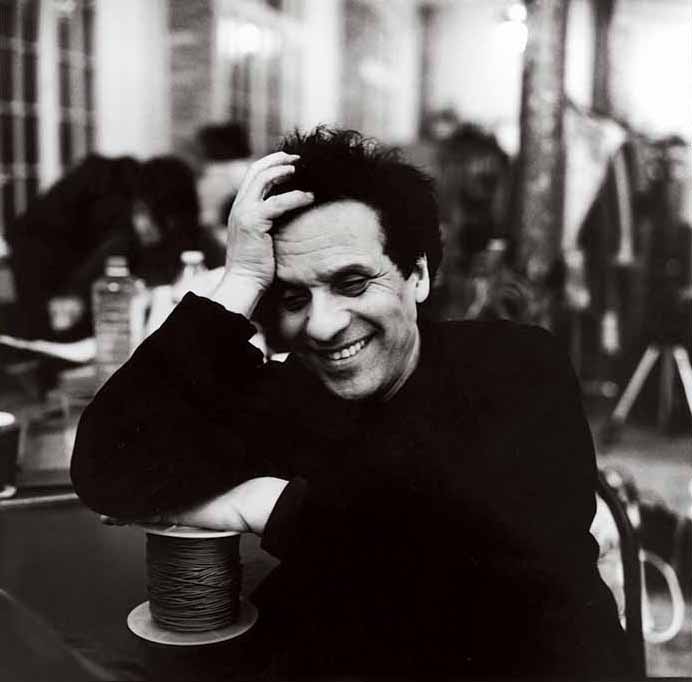
azzedine alaïa photographed by gilles bensimon
By becoming a friend of the Azzedine Alaïa Foundation, you are helping to enrich and promote a unique collection of art, design and fashion objects built up by the couturier throughout his life.
18 rue de la verrerie
When I visited this place, I liked that it has an industrial aspect. I went for it. There will be everything inside, it's a very large space but it's going to be occupied, all of it, every last bit. Azzedine Alaïa

azzedine alaïa ph. Gilles Decamps, 1989
In 1987, Azzedine Alaïa bought a group of buildings in the Marais neighborhood in Paris.
The ensemble consists of a number of vast spaces, all connected to one another, and situated between the rue de la Verrerie and the rue de Moussy. At 18 rue de le Verrerie, in the great glass-roofed hall which had been transformed into an industrial workshop in the 19th century, then a warehouse for the "Bazar de l'Hôtel de Ville" department store, Azzedine Alaïa would create his home and place of work.
The new real estate acquisition of Azzedine Alaïa. Jean Rouzot for « Bains de minuit » © INA
Renovation works uncovered frescos on the walls of large scale geographical maps of faraway regions hand-painted directly on to the plaster of the great glass-roofed hall, built according to the plans of the architect Harouard, remains from a period at the end of the 19th century during which the building housed a charitable restaurant. This restaurant had been a social initiative of François-Xavier Ruel, founder of the department store "Bazar de l'Hôtel de Ville" (1854), with the aim of providing meals to the poorest families for a modest sum.
Driven by his tireless curiosity, Azzedine Alaïa also discovered that at 7 rue de Moussy where once stood "l'Hôtel des Évêques de Beauvais", a young girl, Jeanne Antoinette Poisson, who would later become the "marquise de Pompadour", favorite courtisane of Louis XV, had received within these very walls her education in basic academic subjects aswell in what was known as the "ornamental branches". There she learned skills that would enable the young woman to be received at court, despite not having been born into the aristocracy, and there, thanks to her education and beauty, she would exerce an influence that remains unparalleled throughout the history of the arts. The "marquise de Pompadour" was for Azzedine Alaïa one of the great historical figures, the beauty of a confident elegance, the modern woman. Throughout his life he was fascinated by the extraordinary life of this woman from humble beginnings. She was for him a constant source of inspiration and admiration.
The building renovations initiated by Monsieur Alaïa would take over five years to complete.
In 1990 Azzedine Alaïa left his Hôtel Particulier on the rue du Parc Royal and moved into the new space.
The architectural ensemble houses Azzedine Alaïa's apartment and creative studio, the ateliers, the store at 7 rue de Moussy and the famous kitchen, host to a great many encounters, gatherings and exchanges of ideas.
Here Alaïa created the Summer 1992 collection, one of the first to be created in this new space. The collection references the marquise de Pompadour and the Court of Versailles.I t is also one of the couturier's largest and most emblematic collections.
Alaïa's runway shows, which do not adhere to the calendar of official fashion weeks, take place in the great glass-roofed hall. In the great glass-roofed hall, Azzedine Alaïa would also hold exhibitions celebrating artists he admired: Paul Poiret, Shiro Kuramata, Pierre Paulin, Elsa Schiaparelli, Andrea Branzi, Ettore Sottsass, Bettina Graziani, Kris Ruhs, Jean Nouvel and Claude Parent, Pierre Guyotat, Alejandro Jodorowsky, Richard Wentworth.
At 18 rue de la Verrerie, hommage is continually paid to artists and designers, with works permanently on display, for example "le Sein" by César takes pride of place in the courtyard, in the bookshop and the kitchen, pieces by Le Corbusier, Jean Prouvé, Jean Royère, Serge Mouille, Harry Bertoia and Gino Sarfati interact with one another, lights by Marc Newson adorn the ceilings of the future museum,and the artist Julian Schnabel is ever present throughout the space in his paintings and portraits of Azzedine Alaïa, a testimony of their great friendship.

azzedine alaïa © jean-pierre couderc/roger-viollet
dar alaïa
There is nothing more beautiful and noble than to stand still and look up to the sky. Azzedine Alaïa

Azzedine Alaïa © azzedine alaïa foundation
Perched on top of a hill, covered in pine and eucalyptus trees, lies Sidi Bou Saïd: a small village composed of enviously beautiful white houses with blue doors. Its picturesque view overlooks the entire Mediterranean, as well as the ancient city of Carthage. It is here, at the summit of this hill, that Azzedine Alaïa chose to construct his home in 1986 to connect once again back to his roots.
Azzedine Alaïa knows Sidi Bou Saïd well. During each visit to the village, he would stay with his close friend Latifah – who he met in the 1950’s at the l’école des beaux-arts in Tunis – and her husband Jalel Ben Abdallah, the well-known Tunisian painter.
It is in Sidi Bou Saïd that Alaïa rediscovered the Tunisia dearest to his heart, as well as the place which served as inspiration to many of his collections redolent of the Mediterranean. The silhouettes used in the collections oftentimes mimic the antique columns of Carthage and the Moorish architecture, while the motifs recall arabesque figures, Arabic calligraphy and moucharaby structures. The shirt dresses are a nod to Tunisian dress, while the white blouses are reminiscent of the ensembles worn by the Sisters of Notre-Dame-de Sion, whom Alaïa would have often encountered in Tunis throughout his adolescence.
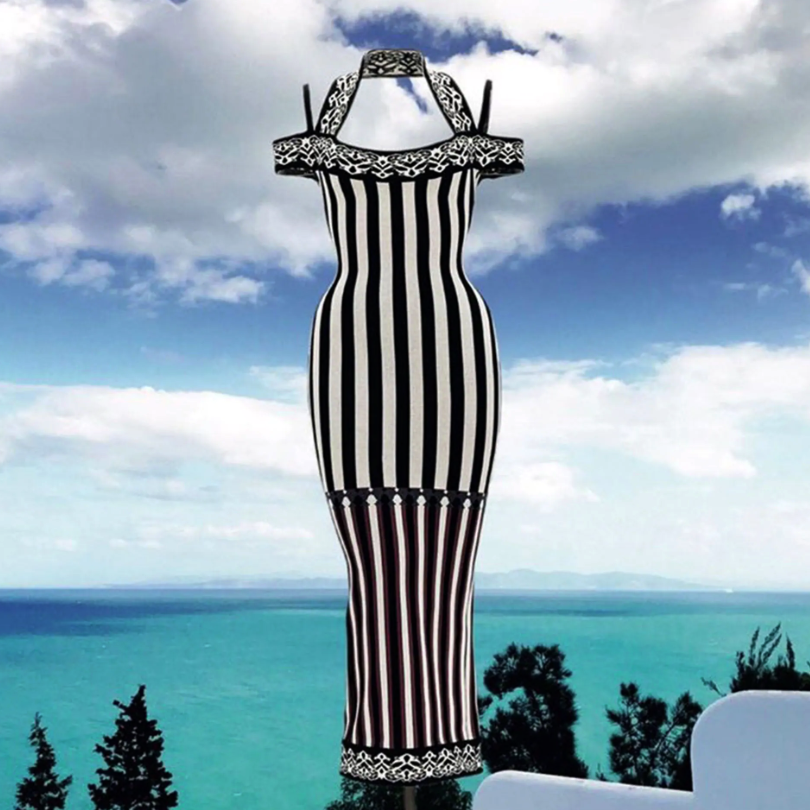
azzedine alaïa © azzedine alaïa foundation
“Azzedine said there was a piece of abandoned land attached to Latifa and Jalel’s property. It held a small building in ruin, overlooking the ocean, where a farmer had left his donkey to graze. Azzedine had bought the land for constructing his new home, but Sidi Bou Saïd is attached to city of Carthage, which was recently classified as a world heritage site by UNESCO (1979). This classification made any new construction project very difficult… but the plans for the home, which were drawn by the famous contemporary Tunisian painter Jalel Ben Abdallah, convinced everyone that the project should go forth.”
The home echoes the Arab-Andalusian architecture of the village: cubic construction, a small dome on the roof, white-washed walls, moucharaby windows, alternating white and blue shutters, various balconies, a large terrace adorned in fine wrought iron balustrades,and wooden doors framed in horseshoe-shaped arches.
The interior garden, hidden from view, offsets the white austerity of the walls with its luxurious vegetation and vibrant colors: flamboyant bougainvillea, jasmine flowers, and cypress bloom alongside the date palms and pines that rise high above the flat roofs.
Throughout the years, Azzedine Alaïa would rarely spend time at the property, and would often stay with his friend Latifa when visiting the village. Because of this, he never had the time to properly furnish the home, which resulted in its minimal interior decoration.
Since Azzedine Alaïa’s passing, the Azzedine Alaïa Foundation has named the home “Dar Alaïa” and the location is used to display exhibitions that celebrate the memory of the designer.
In 2018 “Azzedine Alaïa, The Mediterranean”, was an homage to the designer’s Tunisian origins and how they inspired his collections. The installation displayed a selection of twelve robes chosen from his Spring 1992 Collection. In 2019, the Foundation exhibited,“Looking for Oum Kulthum”, a film created by the Iranian artist Shirin Neshat. Azzedine Alaïa was a great admirer of the singer and Egyptian actress Oum Kulthum, whom he had discovered as a young boy at the Ciné Soir film screenings in Tunis.
In conjunction with the film “Looking for Oum Kulthum”, the Foundation held the exhibition titled “Black Dresses,”which featured a couture dress that Azzedine Alaïa had made for Latifa alongside black and white dresses created by young Tunisian designers.
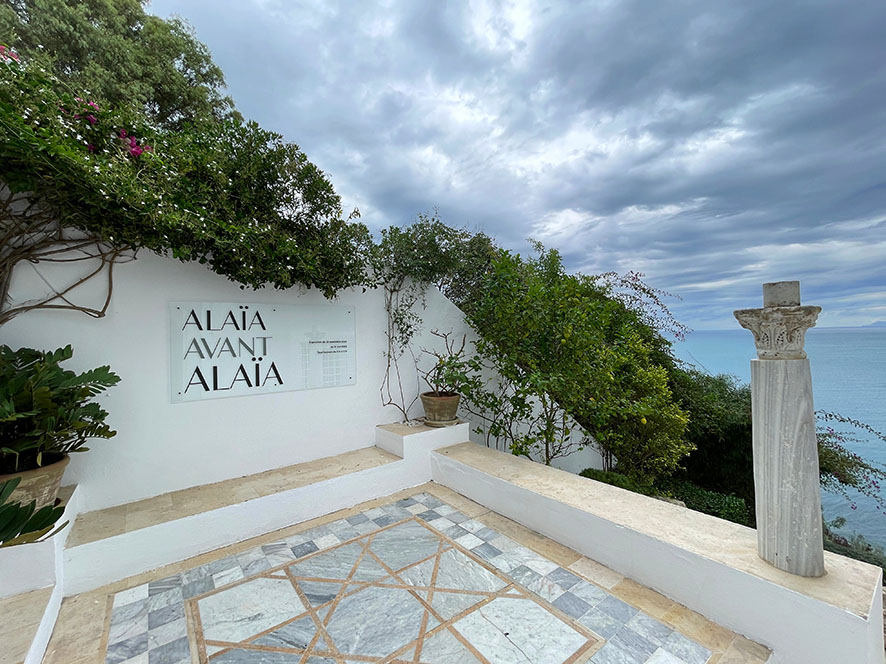
Dar Alaïa, sidi bou saïd ph.Sylvie Delpech
In some places, there is no real measure of time, only day and night.
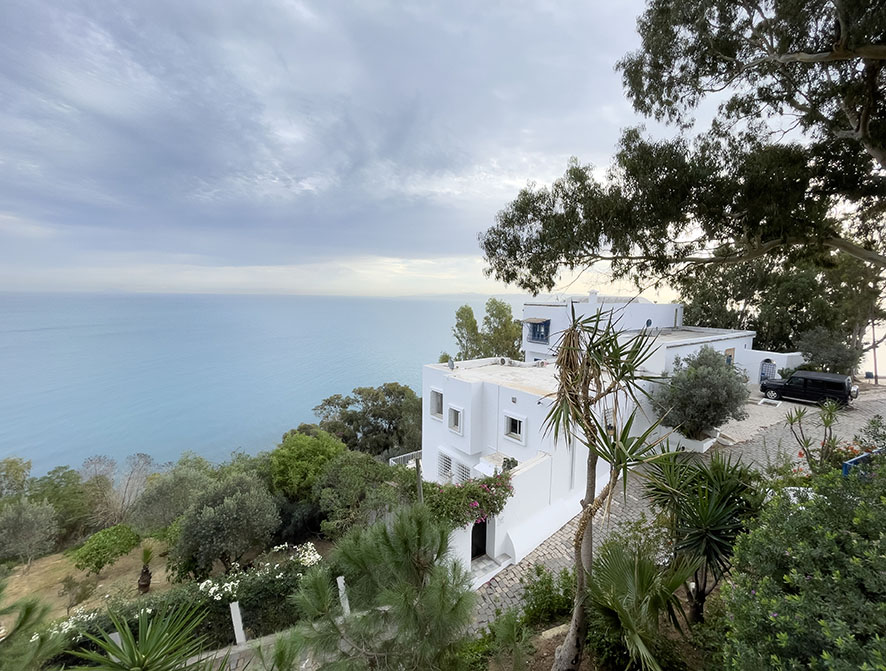
Dar Alaïa, sidi bou saïd ph.Sylvie Delpech
The World of Leila Menchari
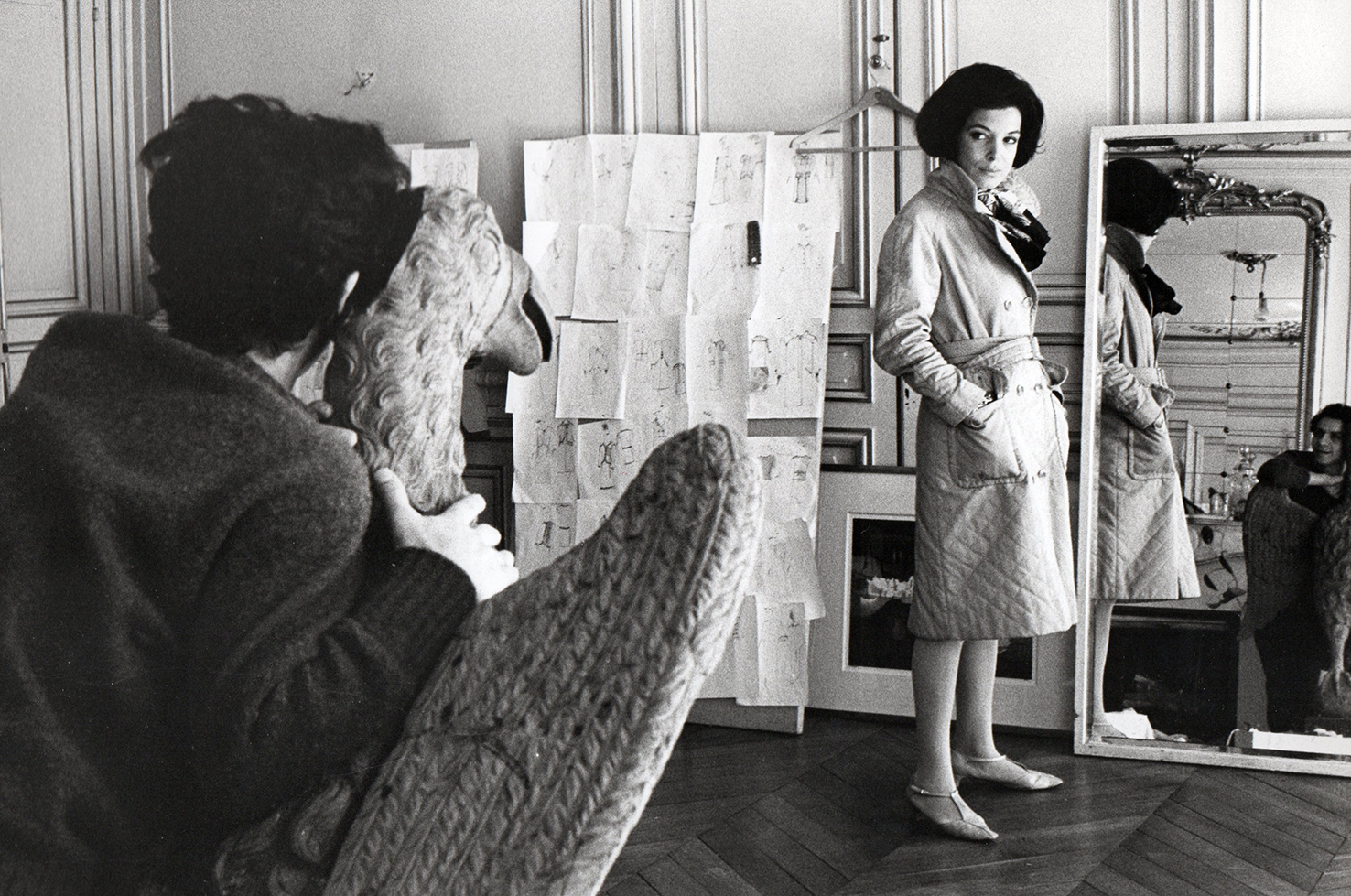
leila menchari and azzedine alaïa, rue de Bellechasse ph. jean-pierre Ronzel
“I never had the feeling of having one day met Azzedine, he always seemed to have been a part of my life forever. My mother noticed his talent very early on.” Leila Menchari
The life paths of Leila Menchari and Azzedine Alaïa have been intimately intertwined, united by an uninterrupted amicable and affectionate relationship which started very early on in the life of the designer.
While the young Azzedine Alaïa was still a student at the School of Fine Arts in Tunis, Leila Menchari’s mother showed him, in person, a benevolence that would give him the reassurance to one day move to Paris.
Leila, a young School of Fine Arts graduate, was also on the verge of moving to the French capital to subsequently become a model, illustrator, and artist. She would later become one of the most famous creators of the window displays at the Maison Hermès.
Leila and Azzedine lived together in Paris and cultivated a strong bond spirit and creativity. Together, they both seized on the unique opportunities provided by their surrounding social and artistic networks.
More often than not, Leila Menchari, with her ease in social situations, was able to accompany, support, and encourage the aspiring couturier Azzedine Alaïa even during the most vulnerable and fragile moments at the Maison Hermès. Leila acted as a force of consistency in the artistic balance of the couturier. As Alaïa’s lifelong friend, she was involved in all of the important events in his life and was endowed with a strong personality. She was able to open Alaïa to other artistic perspectives while being a witness to his career and a driving force to his ambition.

leila menchari and azzedine alaïa ph. jean-pierre Ronzel
The mother of my childhood friend, Leila Menchari, knew a Dior client and asked her to help me get into the Maison. Azzedine Alaïa
"How could such a shy young boy, coming from the middle class, visited neither by European people nor the bourgeoisie, dressing the dolls of his sister Hafida, find himself frequenting high society?" Leila Menchari
"With his best friend, the soul mate of the late Azzedine Alaïa, we would often meet up together. Each meeting with Leila and Azzedine was a unique and unforgettable trip to the land of refinement and beauty." Jack Lang, former Minister of Culture, President of l’Institut du Monde Arabe, extract from his tribute to Leila Menchari, April 6, 2020.
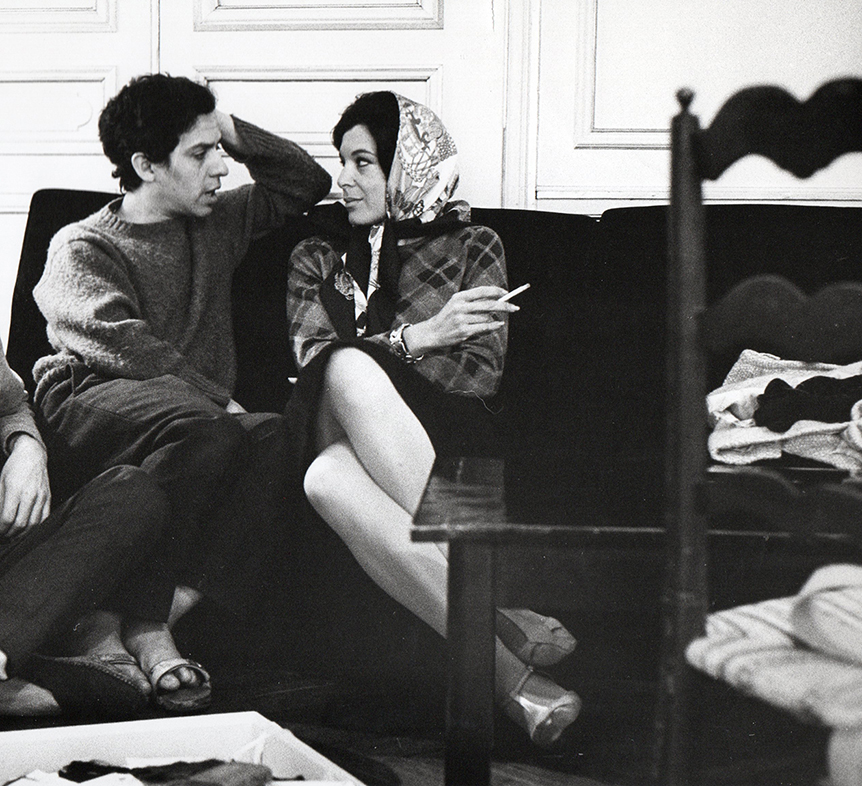
leila menchari and azzedine alaïa, rue de Bellechasse ph. jean-pierre Ronzel
United by an unwavering friendship, Leila and Azzedine were committed to defending and promoting shared interests, including:
• The identification, promotion and support of different forms of Tunisian, and more generally Mediterranean, craftsmanship and know-how;
• The emancipation and defense of women’s causes in Tunisia and the Mediterranean;
• Accompanying and supporting young talents and Tunisian fashion designers, which will later extend to the entire African continent.
The Leila Menchari Endowment Fund and the Azzedine Alaïa Foundation are both working towards common objectives. At the wish of Leila Menchari, this fund is chaired by Philippe Ginestié and supported by Mrs. Aïcha Ben Abeb, who has maintained great bonds of friendship and intellectual complicity with Leila Menchari for over 30 years. Both women believed in investing in and representing Tunisian women in the world of art. This fund will participate in the promotion of Tunisian art and craftsmanship, the promotion of women’s status in Tunisia, and undertaking charitable operations relating in particular to the sectors of health and education in Tunisia.
The objectives of “The World of Leila Menchari” endowment fund are:
- Transmitting the memory of the life, work, and style of Leila Menchari;
- Transmitting the memory of the success of two Tunisian immigrants in France, Leila Menchari and Azzedine Alaïa, emphasizing the similarity of their respective approaches and destinies;
- Undertaking actions which promote the knowledge of the work and values of Leila Menchari in connection to those of Azzedine Alaïa;
- Participating in the promotion and status of women in Tunisia;
- Undertaking charitable actions in Tunisia that may relate to health and education in particular.
FOUNDERS
AÏCHA BEN ABED
FONDATION AZZEDINE ALAÏA
PHILIPPE GINESTIÉ
PRESIDENT
Philippe Ginestié
CONSEIL
AÏCHA BEN ABED
FONDATION AZZEDINE ALAÏA
PHILIPPE GINESTIÉ
UGO SUPINO

